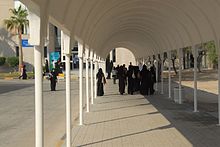- Education in Bahrain
-
 Students at the University of Bahrain
Students at the University of Bahrain
Bahrain has the oldest public education system in the Arabian Peninsula. The system was established in 1932 when the government assumed responsibility for operating two preexisting primary schools for boys. Subsequently, separate facilities for girls and various secondary programs were established. Since the 1970s, education has been one of the largest current government expenditures. Despite the intensity of government efforts, however, the literacy rate for adult citizens was only about 75 percent as recently as 1985. The literacy rate for 1990 was estimated by the United Nations Educational, Scientific, and Cultural Organization (UNESCO) to be 77 percent for adults (82 percent for males and 69 percent for females). Nevertheless, literacy levels among Bahrainis born since independence in 1971 were high because an estimated 70 percent of primary and secondary school-age children attended school.
In the 1986–87 academic year, 88,152 students attended 139 public schools (see table 13, Appendix). Education in the public system, which included six-year primary schools, three-year intermediate schools, and three-year secular secondary schools, is free. Students receive supplies, uniforms, meals, and transportation to and from school at no charge. Almost all children in the six- to eleven-year-old age-group attend primary school, and about two-thirds of all twelve- to fourteen-year-olds are enrolled in intermediate schools. However, there was a significant drop-out rate, especially for girls, after the completion of intermediate school. In the 1986–87 academic year, only 41 percent of fifteen- to seventeen-year-olds attended secondary schools.
In the academic year of 2008/2009 the number of public classes in Bahrain ( including religious classes) are 4326, with the number of male students 62381 and female students 63233. with a distribution of 62172 in primary classes, 32327 in preparatory classes (junior high) and 31115 in secondary schools.
In addition to the public education system, there are forty-eight private and religious schools, including the United States operated and accredited Bahrain International School, which offers classes from primary school through secondary school. There were 5,000 teachers in 1988, of whom 65 percent were native Bahrainis. Egyptians constituted the largest group of foreign teachers. Bahrain also is home to St Christopher’s School,which the Guardian has named as one of the eight best international schools in the world, the only school in the Middle East to make the list. 10 universities provide internationally-recognized qualifications.
In 1927 the first group of Bahrainis to receive a university education enrolled at the American University of Beirut in Lebanon. The first institution of higher education in Bahrain, the Gulf Polytechnic, was established in 1968 as the Gulf Technical College. In 1984 Gulf Polytechnic merged with the University College of Art, Science, and Education (UCB), founded in 1979, to create a national university offering bachelor of arts and bachelor of science degrees. During the 1991–92 academic year, more than 4,000 students, half of whom were women, studied at the two campuses of UCB/Polytechnic.
In 2008 a new Bahrain Polytechnic opened on the University of Bahrain's old campus location at Madinat Isa.
Bahrain had three additional institutions of higher education in 1993. The College of Health Services, established in 1976, offers various medical technology and nurses' training programs. The Hotel and Catering Training Center offers postsecondary vocational courses in management and culinary arts. The newest institution, the Arabian Gulf University (AGU), was established outside Ar Rifaa in 1984 and funded by the six member countries of the GCC. Construction of AGU facilities, however, was delayed by the decline in oil revenues experienced by all GCC states in the mid-1980s. The first faculty, the College of Medicine, opened in the fall of 1989 and provided medical education for fifty-eight aspiring physicians. The projected completion date for the AGU campus is 2006; officials anticipate that AGU will accommodate 5,000 students annually, once the university becomes fully operational.
The AGU campus has been completed to conatin a faculty of medicine, faculty of agriculture and recently her Princess Jawhara of Saudia Arabia donated a centre for molecular biology & inherited disorders. Built right across the street from the campus to encourage the development of regional research in this issue.
Further liberalisation of the education sector has occurred in Bahrain. New private universities are sprouting up by the day, which has led to a low standard of education in some of these private establishments. This low standard has led to the establishment of a quality assurance body that places under scrutiny all the programs offered by each university and currently there are 10 private universities that are warned to adjust their situation or face being shut down.
See also
- List of educational institutions in Bahrain
References
 This article incorporates public domain material from websites or documents of the Library of Congress Country Studies.
This article incorporates public domain material from websites or documents of the Library of Congress Country Studies.External links
- Bahrain Polytechnic
- Ministry of Education
- [http://www.ArabianCampus.com Education Portal
States with limited
recognition- Abkhazia
- Nagorno-Karabakh
- Northern Cyprus
- Palestine
- Republic of China (Taiwan)
- South Ossetia
Dependencies and
other territoriesCategories:
Wikimedia Foundation. 2010.
